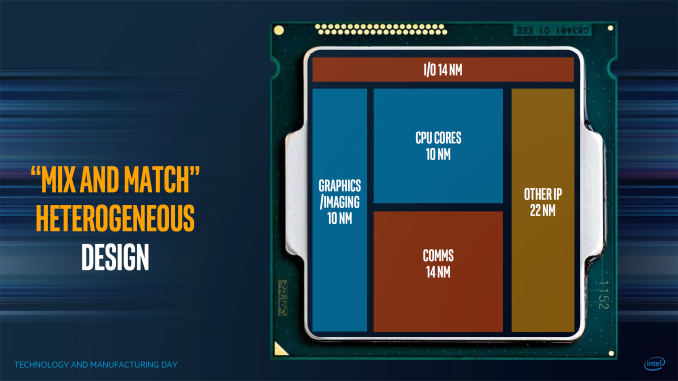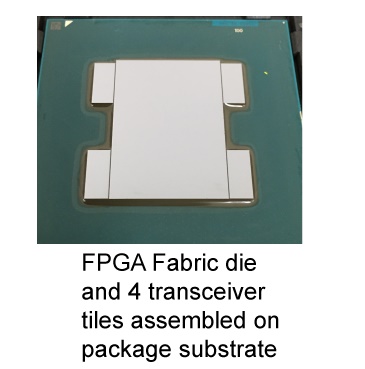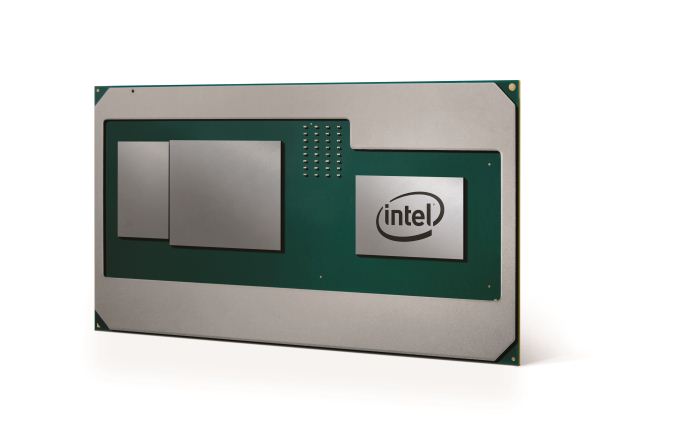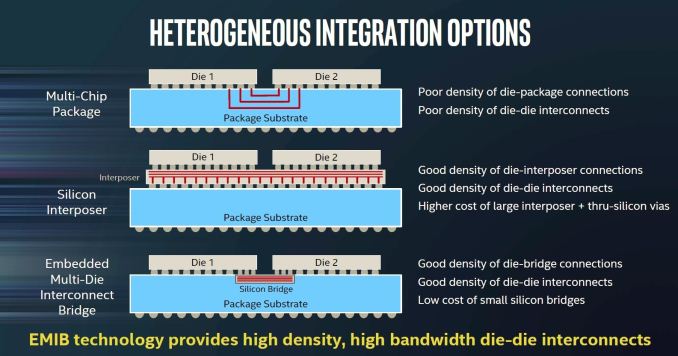
Today we have an announcement out of left field. Intel has formally revealed it has been working on a new series of processors that combine its high-performance x86 cores with AMD Radeon Graphics into the same processor package using Intel’s own EMIB multi-die technology. If that wasn’t enough, Intel also announced that it is bundling the design with the latest high-bandwidth memory, HBM2.
Intel announced its EMIB technology over the last twelve months, with the core theme being the ability to put multiple and different silicon dies onto the same package at a much higher bandwidth than a standard multi-chip package but at a much lower cost than using a silicon interposer. At Intel’s Manufacturing Day earlier this year, they even produced a slide (above) showcasing what might be possible: a processor package with the x86 cores made on one technology, the graphics made in another, perhaps different IO and memory or wireless technologies too. With EMIB, processor design can become a large game of Lego.
EMIB came to market with the latest Intel Altera FPGAs. By embedding the EMIB required silicon design into the main FPGA and each of the chipsets, the goal was to add multiple memory blocks as well as data transfer blocks in a mix and match scenario, allowing large customers to have the design tailored to what they require. The benefits of EMIB were clear, without the drawbacks of standard MCP design or the cost of interposers: it would also allow a design to go beyond the monolithic reticle limit of standard lithography processes. It was always expected that EMIB would have to find its way into the general processor market, as we start to see high-end server offerings approaching 900 mm2 over multiple silicon dies in a single package.
Since the EMIB announcements, Intel’s Manufacturing Day, and Hot Chips, word has been circulating about how Intel is going to approach this from a consumer stand point. As part of the requirements of Intel’s own integrated graphics solutions, a 2011 cross-licensing deal with NVIDIA was in place – this deal was set to expire from April 1st 2017, and no mention of extending that deal was ever made public. A couple of rumors floated around that Intel were set to make a deal with AMD instead, as despite their x86 rivalry they were a preferred partner in these matters. Numerous outlets with connections in both AMD and Intel had difficulty prizing any information out. Historically Intel refuses to comment on such matters in advance. Other potential leaks include published benchmarks over at SiSoft, although nothing has been made concrete until today.
Intel’s official statements on the announcement offer a few details worth diving into.
The new product, which will be part of our 8th Gen Intel Core family, brings together our high-performing Intel Core H-series processor, second generation High Bandwidth Memory (HBM2) and a custom-to-Intel third-party discrete graphics chip from AMD’s Radeon Technologies Group* – all in a single processor package.
Intel interestingly uses a singular word for ‘product’, although this does not indicate if it is a family or literally a single SKU in the works. On Intel’s Core-H series processors, these are currently Kaby Lake based running at 45W, with Intel’s integrated GT2 graphics. It would be interesting to see if the graphics of the Core-H are then stripped out as a new silicon design, or if they are re-spinning the full Core-H silicon as a result and just displaying the integrated cores, or are able to run both graphics segments independently (it is likely a new spin of silicon, if I were a betting man). The use of HBM2 is not unsuprirising – Intel has successfully integrated HBM2 into its Altera EMIB-based products so we would suspect that this is not going to be overly difficult.
The next bit is the interesting one: ‘custom-to-Intel … discrete graphics chip’ from AMD RTG. This means that none of AMD’s current product stack has silicon dedicated to EMIB, but AMD is going to leverage its semi-custom design to provide graphics chiplets for Intel to add to its silicon.
‘In close collaboration, we designed a new semi-custom graphics chip, which means this is also a great example of how we can compete and work together, ultimately delivering innovation that is good for consumers… Similarly, the power sharing framework is a new connection tailor-made by Intel among the processor, discrete graphics chip and dedicated graphics memory. We’ve added unique software drivers and interfaces to this semi-custom discrete GPU that coordinate information among all three elements of the platform.’
One of the questions about running multiple chips in a single package is how to manage all the bandwidth and power. AMD has recently solved that issue in its server processors and inside its APUs by using their Infinity Fabric, which if I were to guess would not be under the purview of this collaboration. It states that with collaboration that the chip shares a power framework, which will be an interesting deep dive when we get information as to whether Intel offering separate power rails for the CPU and GPU segments, using an integrated voltage regulator (like Broadwell did), or doing something similar to AMD by using a unified power rail sharing mechanism with digital LDOs as was announced with Ryzen Mobile only a couple of weeks ago.
‘Look for more to come in the first quarter of 2018, including systems from major OEMs based on this exciting new technology.’
It looks like Intel is ready to make some announcements over the next few months on this project, and CES is just around the corner in January.
Though taking a step back, we have to consider what this means and what market Intel is aiming for. AMD recently launched (with products coming soon) their Ryzen Mobile platform, designed with quad-core Zen and up to 10 CUs of Vega graphics. The announcements from Intel and AMD do not state what graphics core they are using (they could be one generation behind for competitive reasons?) however it does state that they are using Core-H series processors, which are typically in the 45W range. AMD currently hasn’t announced anything in that segment, and deciding to focus Ryzen Mobile at the thin and ultralight notebook categories first. If AMD does bring Ryzen Mobile up, then this new product will be in direct competition.
Looking at the image provided by Intel on the new product arrangement actually adds a new question or two to the bucket list. Here we have an Intel chip on the right, the AMD custom graphics in the middle, and the HBM2 chip next to it. The Intel chip is a long way away from the AMD chip, which would suggest that these two are not connected via EMIB if the mockup was accurate. The close proximity of the big chip in the middle to what looks like a HBM2 stack does suggest that it is connected via EMIB, as given by how close the chips in the Altera products are:
EMIB is being used, but it does not look like it is being used for all the chips together. It’s worth noting that neither Intel nor AMD offered pre-briefings on this announcement, so there are a lot of unanswered questions hanging around as a result.
A final thought. Apple uses a lot of Intel’s 45W processors for iMacs; offering AMD graphics (Apple’s preferred pro-graphics partner) into the segment that previously Intel’s Crystalwell/eDRAM based products exist might be the next step on that product cycle evolution.
Source: Intel
Source: AMD
Autore: Ian Cutress AnandTech




